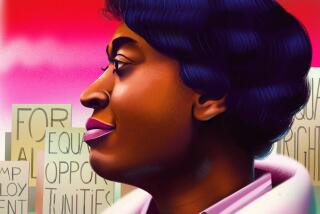A Man With ‘Eyes’ on America Is Gone
It was the mid-1980s, a grim time in Washington if you remembered the social movements of the ‘60s. The Reagan government was in full swing; every weekend evening, women with bouffant hair and fur coats were disgorged from shiny limousines before the porte-cocheres of the city’s best hotels. Everyone seemed to be wearing initials belonging to someone else. Catsup was declared a vegetable for the purposes of downsizing government-subsidized lunches in public schools. The White House glittered even as the legions of poor and homeless grew outside its very gates. Americans were divided on issues of class, race and gender.
I was working at an association for philanthropic organizations, and a friend sent Henry Hampton to me for some funding advice. It was the middle of a long day in the center of an even longer week, but five minutes after he was inside my office, I was glad I had promised to meet with him. Because Hampton had a vision: He wanted to provide us with a video snapshot of America at a time when it fought a moral war with itself and won. He wanted to chronicle the history of the civil rights movement from its earliest stages, in the hamlets of Mississippi and Alabama, through the historic sit-ins to the triumph of the March on Washington and beyond. He wanted to share, he said, “not just the stories of the generals of the civil rights movement--most of us already know those. No,” he’d said leaning eagerly forward, “I want to tell the story of the foot soldiers in the civil rights movement. The people who, literally, risked their property, their livelihood and their lives to force America to live up to her promise of liberty and justice for all.”
He was proposing a series of six one-hour programs to cover each time period, and the series would be called “Eyes on the Prize.” Who wouldn’t want to help? My association didn’t have money, but we knew where to look for it. I sent him to a colleague who had money. She gave him some and sent him to a colleague of hers who had money and so forth. In that way, by dint of Hampton’s unwavering vision and his ability to articulate it brilliantly, with passion and humor, the money for “Eyes” was pieced together, slowly.
And eventually it was done. He brought together people from all over the country--filmmakers, historians, writers and producers--assembled them in racially mixed teams and immersed them in history, written and oral. When you walked into the crowded offices of Blackside Productions in Boston, you heard the buzz of people doing important work, work they loved. Ghosts would waft through the room, some benevolent, some malign, as the films, in various stages of readiness, were played back during editing. Some were historic, famous. Rosa Parks. Fannie Lou Hamer. Eugene “Bull” Connor. George Wallace. But countless others were not. There were ministers of small congregations who urged their flocks to have courage and vote. Housewives who took off their aprons and went downtown to march. Schoolchildren who stood defiantly in the face of the awful pressure of water cannon and who returned repeatedly to be similarly assaulted. Whites from the South and North who felt the time had come for the divided country in which they’d been living parallel lives to knit itself up into one entity. The foot soldiers of the civil rights movement.
The movement, as Hampton liked to say, was not a movement to liberate black Americans only, but one to liberate all Americans. Thanks to Henry Hampton, their stories are now part of our history’s tapestry.
Henry Hampton died earlier this week, at the age of 58, of complications that followed treatment for lung cancer. Those of us who worked for him, whether as paid staff, volunteers or as supporters of his many projects, are thankful, on this week of thanks, to have been allowed into his orbit.
More to Read
The biggest entertainment stories
Get our big stories about Hollywood, film, television, music, arts, culture and more right in your inbox as soon as they publish.
You may occasionally receive promotional content from the Los Angeles Times.










